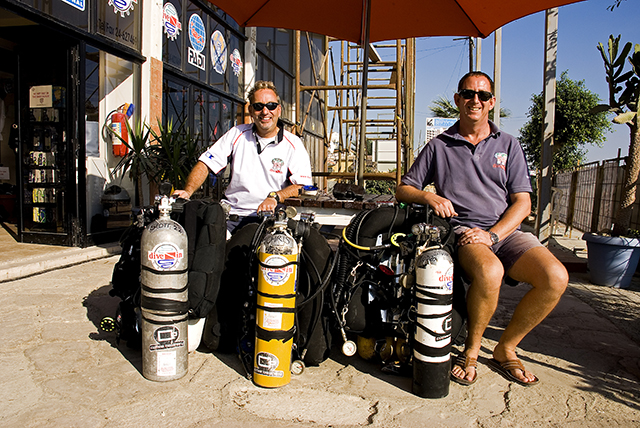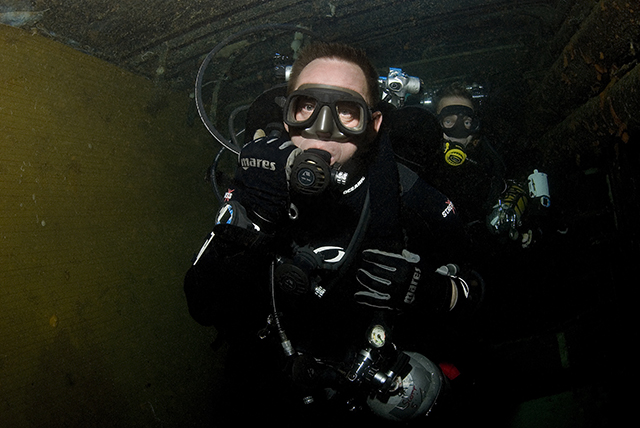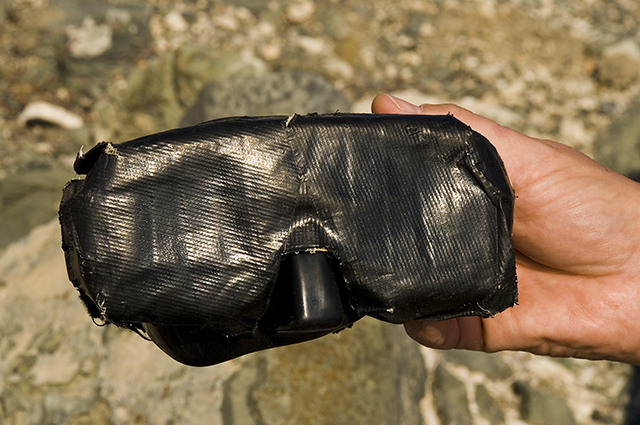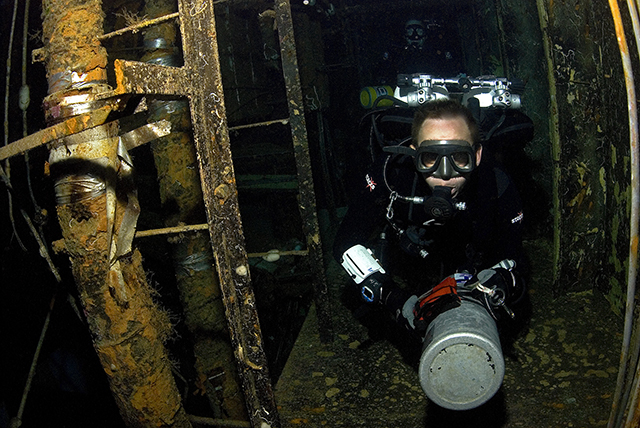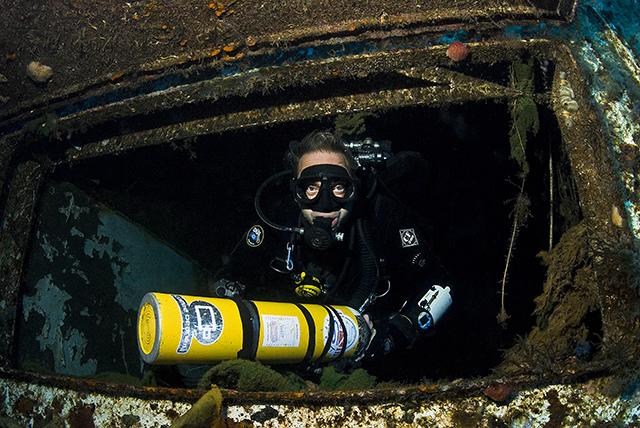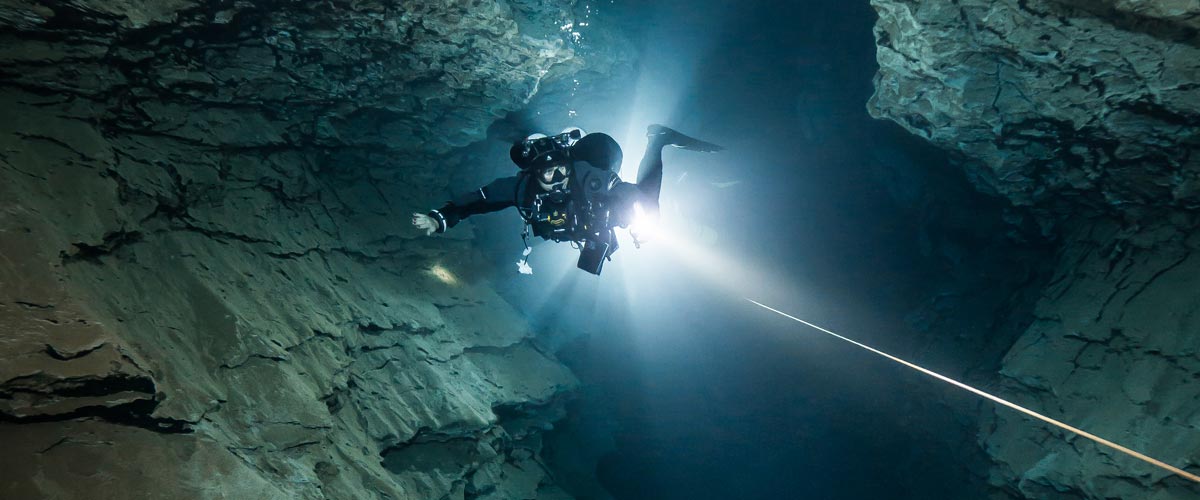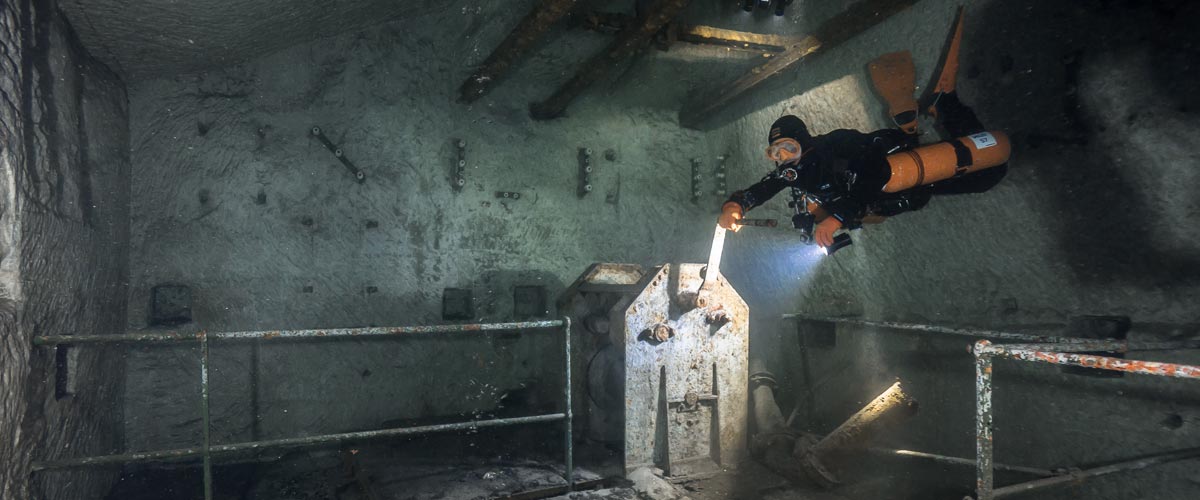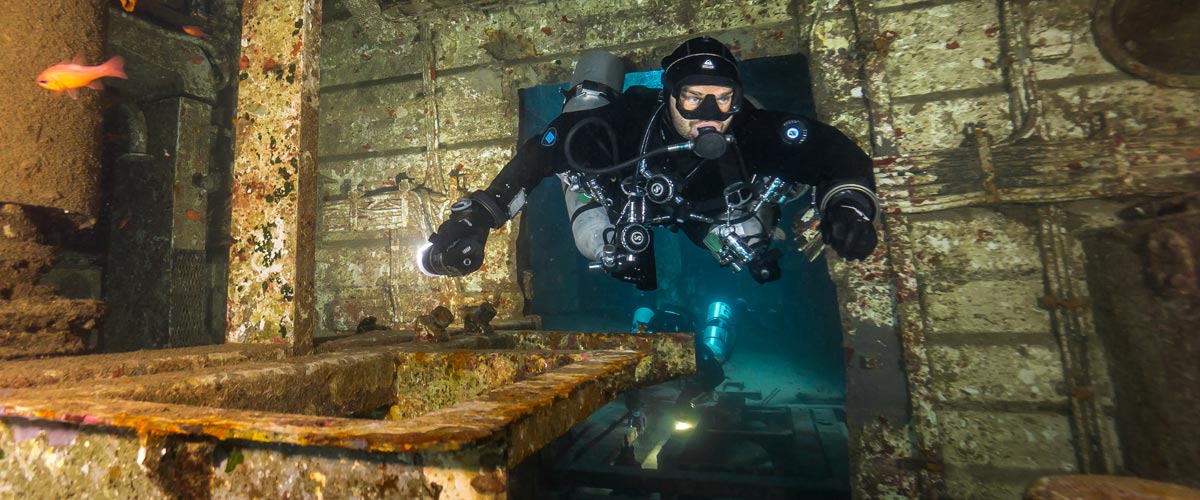Dive Training Blogs
Pitch Black: The TDI Advanced Wreck Diver Course
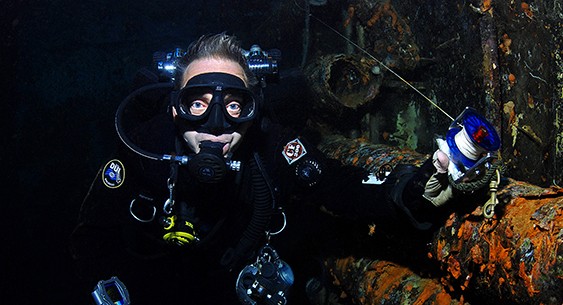
“You’ve just killed everyone,” said Chris Demetriou, the Ops Manager at Dive-In. We had been deep inside the Zenobia, Cyprus’s top wreck site, and sure enough the dive hadn’t gone as planned; but where had I made such a fatal mistake? This was my penultimate dive on the TDI advanced wreck course. The last 3 days had been more psychologically demanding than I had ever imagined. Chris said “I don’t have to load the course with simulated problems, they just happen for real.” He was right; pitch black with no lights and no guidelines, anything could happen – and it usually did!
The Zen is perfect for technical diver training. The 165-metre long ro-ro ferry lies in Larnaca Bay just a few minutes boat ride from the dive centre. Her demise will always be steeped in controversy and intrigue. The most plausible theory is she sank due to a malfunction with the computerised system controlling her ballast tanks. There has never been any salvage operations. Her cargo of 104 articulated lorries and other machinery still lie untouched inside the holds.
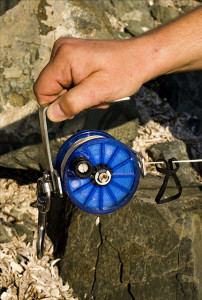
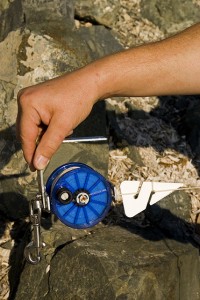 Chris has spent 3 years developing the course itinerary. Most of the training dives are performed in the Officers day room and the Captains bedroom. Although the two rooms are totally enclosed there is plenty of light coming from a row of windows above. Chris explained “you don’t need to go deep inside for the course.” The Zen lies on her port side so doorways, walls and ceilings are not where they are expected to be. Chris said “When planning any penetration dives it’s important to consider room orientation and overall wreck layout.”
Chris has spent 3 years developing the course itinerary. Most of the training dives are performed in the Officers day room and the Captains bedroom. Although the two rooms are totally enclosed there is plenty of light coming from a row of windows above. Chris explained “you don’t need to go deep inside for the course.” The Zen lies on her port side so doorways, walls and ceilings are not where they are expected to be. Chris said “When planning any penetration dives it’s important to consider room orientation and overall wreck layout.”
Although there are some theory sessions, most of the 4-day course concentrates on practical exercises. Ex-Londoner Chris said “this is my favourite TDI course – we’ve run about 10 this year.” He much prefers to teach only two divers per course. Minimum requisites are PADI Advanced diver with the wreck specialty and 50 logged dives or any certifying agency with a wreck familiarisation certificate and the prescribed number of dives. Divers really have to be in the right mind set for this course. Chris said “we don’t have to fail anybody – they fail themselves.” He continued “this course is not for Badge Collectors. By the end of the second day I know if they are going to make it or not.”
My first dive was basically an orientation. This gave me a chance to get familiar with the wreck’s key features and my own equipment configuration. I had been partnered up with Scott Ayrey, an experienced Tri-mix diver. All participants have to wear twin sets with a stage cylinder. Chris prefers to keep his kit as streamlined and as basic as possible: “I don’t want to look like a Christmas tree diver,” he says. There are no cobra heads or cages covering the manifolds or rubber boots and nets on the cylinders. Chris said “it all ends up snagging on the wreck.”
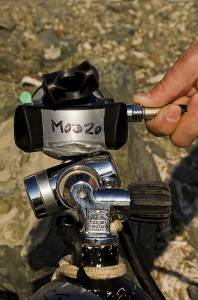 Chris guided us to the bulkhead door that led into the Officers day room. We checked depth and time before entering. Our first task was to draw a map of the entrance and any distinguishing features inside the room. Over the next few dives Scott and I would become quite familiar with the layout. We then performed a number of gas isolation exercises simulating a fractured manifold or a dislodged regulator. A catastrophic gas leak in an enclosed, overhead environment is a real threat. Chris showed us what to do and then it was just a case of following the procedure step by step in a calm co-ordinated manner. All the skills are performed at around 25 metres. There is no need to go any deeper.
Chris guided us to the bulkhead door that led into the Officers day room. We checked depth and time before entering. Our first task was to draw a map of the entrance and any distinguishing features inside the room. Over the next few dives Scott and I would become quite familiar with the layout. We then performed a number of gas isolation exercises simulating a fractured manifold or a dislodged regulator. A catastrophic gas leak in an enclosed, overhead environment is a real threat. Chris showed us what to do and then it was just a case of following the procedure step by step in a calm co-ordinated manner. All the skills are performed at around 25 metres. There is no need to go any deeper.
We stopped during the ascent to switch over to our 50% stage cylinders. Gas switching computers made decompression management a whole lot easier. Permanent marker buoys have been placed at the stern, amidships and bow of the Zen and there is even a trapeze set up at 5 metres to make any stops more comfortable.
The following training dives mainly focused on lost mask procedures, laying/retrieving a guideline and using Scott’s long hose in an out of air scenario. It was well worth spending the first few moments of each exercise gaining composure and thinking about logistics i.e. make sure the long hose is free of any restrictions when air sharing and remembering to keep the line placement as simple and snag free as possible. It also taught me the importance of carrying a back up mask and at least two cutting devices. As Chris had said “it’s the simple things that are life saving.”
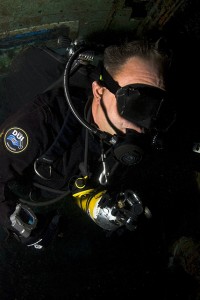 Dive number 4 is probably the toughest of them all. I had to wear Chris’s special blacked-out mask and find my way out of the room by feel alone. It was similar to playing the party game ‘put the tail on the donkey’ but on a much grander scale. Chris spun me around and moved me up and down so I was totally disorientated. There was no guideline this time so my only hope was remembering the room layout and trying to find a familiar object to use as a reference point. My whole sense of perception was left in a severe state of chaos and confusion! I knew from my map that there was a carpet on one side and a row of pipes on the other. My gut reaction was to ascend until I bumped my head on the windows and then move across to a corner where I could hopefully find the carpet. Eventually after 10 minutes of fumbling about my fingers tips felt the familiar texture of woollen fibres. From there on I knew that this would eventually lead to the bulkhead door and freedom! Chris said that the record for escaping was 2-3 minutes but some divers had taken more than an hour to find their way out.
Dive number 4 is probably the toughest of them all. I had to wear Chris’s special blacked-out mask and find my way out of the room by feel alone. It was similar to playing the party game ‘put the tail on the donkey’ but on a much grander scale. Chris spun me around and moved me up and down so I was totally disorientated. There was no guideline this time so my only hope was remembering the room layout and trying to find a familiar object to use as a reference point. My whole sense of perception was left in a severe state of chaos and confusion! I knew from my map that there was a carpet on one side and a row of pipes on the other. My gut reaction was to ascend until I bumped my head on the windows and then move across to a corner where I could hopefully find the carpet. Eventually after 10 minutes of fumbling about my fingers tips felt the familiar texture of woollen fibres. From there on I knew that this would eventually lead to the bulkhead door and freedom! Chris said that the record for escaping was 2-3 minutes but some divers had taken more than an hour to find their way out.
Our last day involved planning and implementing two relatively ‘simple’ wreck penetration dives. Scott and I would enter through the bridge and take it turns to lay the line from the laundry room to the upper car deck. On the way out we would simulate an out of air and a ‘light out’ situation. Chris told us we should always carry a primary light and two back-ups in case of any failure. As I had already found out on Dive 4 having no lights inside a wreck is a nightmare scenario.
Scott was first. He had to lay the guideline. I always thought there would be plenty of pipes, hinges and handles to wrap the line around but it’s not that easy. Chris said that on a previous course one diver had wrapped the line around a floating plastic sheet. This is obviously not a good tie off point for a guideline! Chris had already showed us snoopy loops, line arrows and suitable tie off’s so we were clued up and ready to go.
On the return I was in front using Scott’s long hose. We were in single file along a narrow passageway. It was absolutely pitch black so I slowly and methodically ran my fingers along 10 metres of thin line back to the primary tie off point. Along the way we had to negotiate a tight hatchway and go up and over a doorway. If I moved too fast the regulator would be pulled from my mouth and if I let go of the guideline I would be totally lost. I was 100% dependent on Scott and really didn’t like this feeling of helplessness. We eventually got back to our entry point and completed the training exercise.
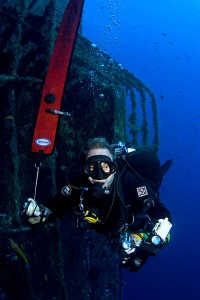
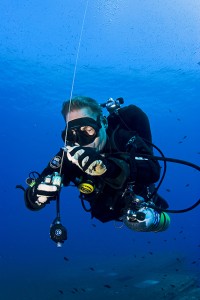 Then it was my turn. This is where my lack of experience laying guidelines really caught me out. There was another guideline already inside the wreck leading off to a different room. I put my primary tie off on the existing line and reeled in from this point. Directional arrows are tied on the line to show the way out but I placed my arrow on the wrong line. This meant we would have got completely lost inside the wreck. Chris said “you won’t make that mistake again.” He was right and this was by far the best way to learn. The more problems we encountered on the course meant it was less likely to occur in real life.
Then it was my turn. This is where my lack of experience laying guidelines really caught me out. There was another guideline already inside the wreck leading off to a different room. I put my primary tie off on the existing line and reeled in from this point. Directional arrows are tied on the line to show the way out but I placed my arrow on the wrong line. This meant we would have got completely lost inside the wreck. Chris said “you won’t make that mistake again.” He was right and this was by far the best way to learn. The more problems we encountered on the course meant it was less likely to occur in real life.
This course gives a whole new meaning to playing around in the dark! Although it was a tough 4 days I enjoyed every moment. We started off with the basics and worked our way up to some heavy task loading exercises. Chris made sure we had a thorough de-briefing after each dive. This gave us a chance to sit down and discuss any problems and go over remedial actions. I soon realised that it’s essential to keep a cool head. It also pushed home the fact that my buddy had to be just as level headed. I was lucky to have Scott as my partner. All I can say is choose wisely! Chris said “Panic will kill you all day long; the key is to never give up.” All of the skills were performed in a ‘controlled’ environment and Chris was always close at hand if any real problems had occurred. Although I had completed all the training exercises I still couldn’t stop thinking how would I react in a real life situation? Pitch-black, deep inside the wreck, no guidelines and no buddy… what would I do?
Information
Contact Dive-In for more information on package prices including B&B accommodation at the 2-Star San Remo Hotel, located behind the dive centre.
Blogs
Intro to Tech: What is it about?
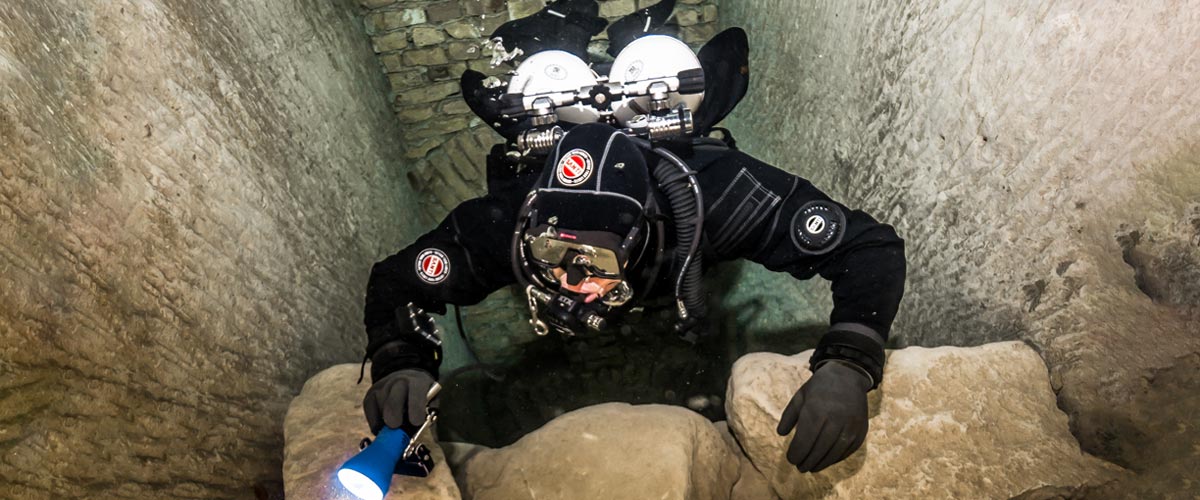
Article by José Pablo Mir
Pictures by Cezary Abramowski
The world of technical diving is exciting. It opens the door to new sites, depths, and bottom times. More importantly, it opens our minds to a new way of planning, facing, and experiencing dives, even those not purely technical.
Becoming a technical diver is a process, and like in other aspects of life, we should find the proper entry point that suits us best based on our knowledge and experience. The Introduction to Technical Diving course from TDI -the world’s largest and most recognized technical diving teaching organization- is the best option for divers who have yet to gain experience in the fundamental aspects of this new practice. The course’s content and its embrace of new techniques and technologies make it possible to acquire a solid foundation to learn and gain experience in this practice properly.
Becoming a technical diver is not something that happens overnight, whether deciding to become one or receiving a certification card stating we are now technical divers. It is a slow process extending farther away than any introductory course. It requires effort and dedication. But it will bring us satisfaction from day one -or two.
It is a matter of mentality
First, we must understand and accept that technical diving, involving greater depths, longer bottom times, exotic gases, virtual or real ceilings, and more, comes with higher levels of risk than the sport diving we have been practicing until now.
Although this discussion usually starts with a warning about risks, as I’ve done in the previous sentence, our practice is not a game of chance.
Technical diving is a rational activity that requires maturity and good judgment, and we will put everything into ensuring that each dive is a successful one -meaning we return from it safe and sound. With this understanding, we will strive to establish a mental attitude more aligned with our practice and its realities.
This new “technical diver” mindset we will develop will lead us to be more cautious in our executions, more analytical in our plans, more rational in our strategies, and more detailed in our procedures.
Experience will keep teaching us to know ourselves better, to keep our anxiety and other emotions under control, and to manage our impulses. Over time, our senses will sharpen, and we will be more attentive to the particulars of the situation we find ourselves in.
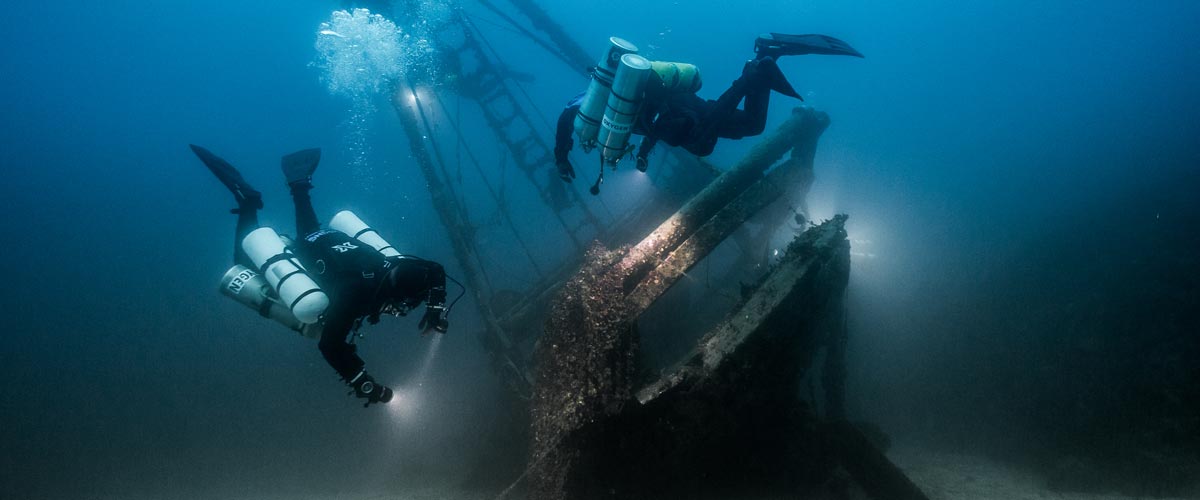
Strategies and procedures
Our strategies, those broad guiding lines tracing the path to follow, from how to approach planning to where, with what, and how we are willing to get there, will be more specific and more practical. Not because they magically become so, but because we will consciously and deliberately frame them that way.
We will establish clear, concise, and realistic procedures. Not only for the undesirable situations that may present themselves but also for those that are part of our dive objectives.
Even though, as technical divers, we often use equipment different from what we were previously accustomed to, it is essential to note that the gear does not make the diver. In a way, we could consider such equipment as the necessary tools to implement what our goal seeks to achieve, according to our strategies and procedures.
Technique plays an important role
We must put our greatest effort into learning and perfecting the different techniques we will be acquiring. Buoyancy, trim, propulsion, cylinder handling, deploying DSMBs and lift bags, valve drills, and more are essential skills we must begin to master to progress in our art. What we cannot do, when we need to do it, can harm us.
Our techniques must be effective and achieve the purpose for which they were devised. But they must also be efficient and require the least resources possible, including the time they take and the effort they demand. Effectiveness and efficiency will prevail over beauty and other considerations that may come to mind, although none of them should be mutually exclusive. A technique executed efficiently and effectively tends to have an inherent beauty.
Refining techniques is a lifelong mission. Some of them will be easy to master from the go; others, on the other hand, will be our life mission and will require many repetitions just to resemble the idea we have in mind of how they should be executed.
We must consider the environment
Our learning, the needs and musts of the practice we engage in, the experience we gradually gain, our strategies and procedures, and even our equipment and tools change with the environment.
Diving in the ocean, everything about us must be suitable for ocean dives. Conditions there rarely emulate those found in a pool, lake, or river. Variable winds and currents, greater depths, visibility conditions, other divers with uncertain skills around us, marine life, maritime traffic, distance from the coast, and many other factors add complexity and uncertainty.
It is never necessary to master the pool on the first day, but planning and aspiring to gradually cope with the ocean’s conditions is essential.
The cost of good training
We are aware that our resources are often scarce in relation to the possibilities of use we could give them if they were not. To a greater or lesser extent, we are part of the economic reality in which we are embedded.
Fortunately, the cost of good technical diver training is not an entry barrier. Comparing training and equipment costs, we see that the former are generally lower. Yes, lower cost for personalized service, essential to our future
performance and safety, than for a series of mass-produced products that are mere, albeit necessary, tools for an end.
The value of good training
The value of the training we received encompasses a range of characteristics, from emotional and methodological to technical and technological. TDI and its Introduction to Technical Diving course offer a deep and modern approach, with a teaching strategy that aims to create thinking divers, not merely obedient ones.
As technical divers, our knowledge is our primary tool. In this type of activity, what we don’t know can harm us.
Is this course optional?
Unfortunately, the fact that this Introduction to Technical Diving course is not a prerequisite for any subsequent training is an invitation to consider it optional. And we all know what usually happens to “optional” under budget constraints.
However, this course should be seen as optional only by those divers who are somehow familiar with the use of technical equipment, who have a mindset more in line with the requirements of this type of diving, who plan and execute the dives the proper “technical” way, who know their gas consumption rate, who are not intimidated by non-decompression tables, who feel comfortable using their dive computers, and know the techniques and have at least an acceptable level of buoyancy, positioning, and propulsion. Those can go straight to a more advanced training course, such as TDI’s Advanced Nitrox.
We must ask ourselves whether or not we are in that group.
Remember our goal: to have fun
Recreational diving is our passion. Jumping into the water carrying heavy equipment and having properly dotted our I’s and crossed our T’s have only one ultimate goal: fun. This is the activity we have chosen as a hobby. We must enjoy it; it must give us pleasure and make us vibrate.
Having a good time is not optional!
Blogs
Four opportunities to go pro in 2024 with Dive Friends Bonaire
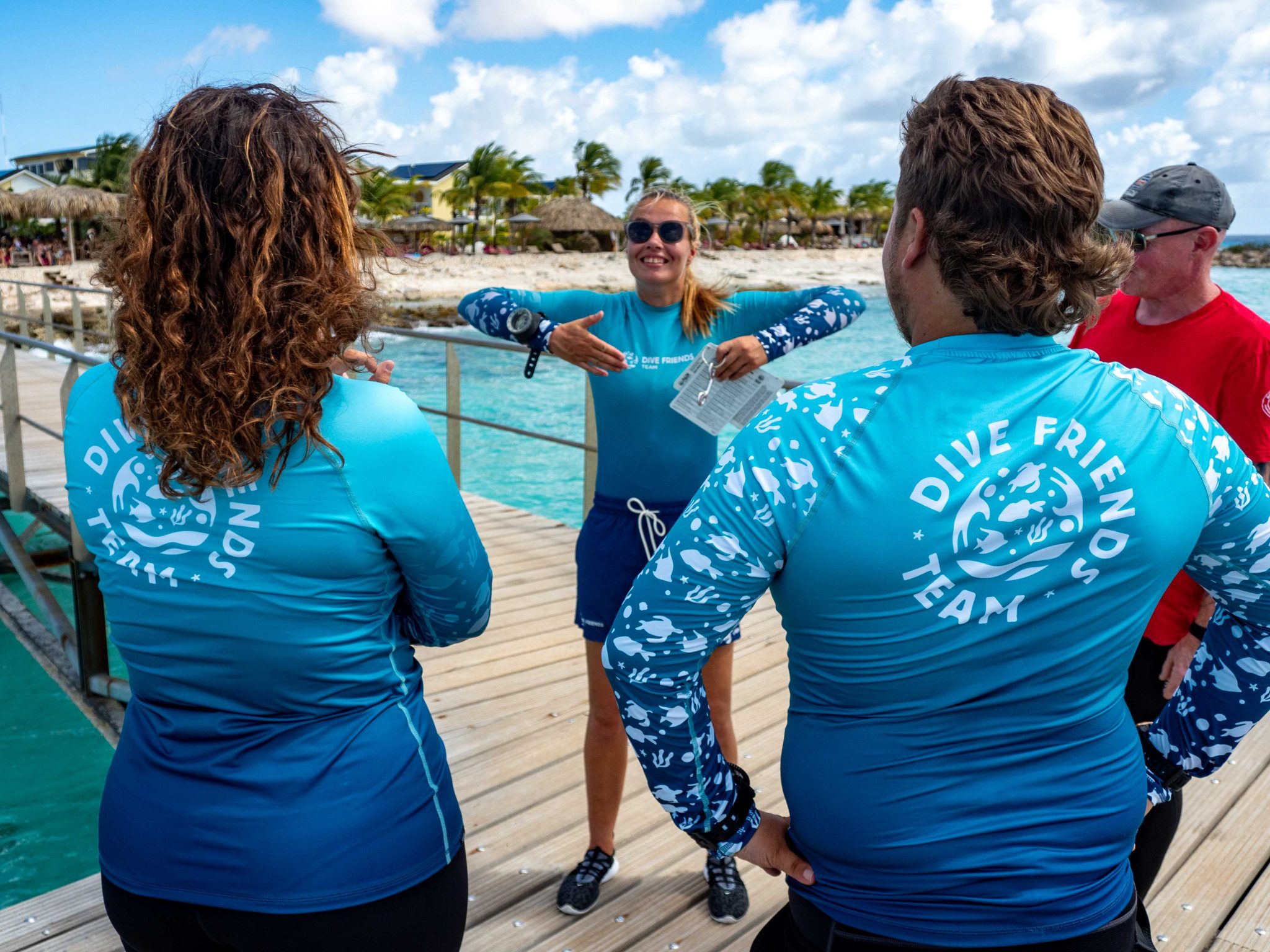
Dive Friends teaches the Instructor Development Course (IDC) several times a year to students who are eager to share their passion for diving with the world.
Dive Friends is known for the personal approach throughout the course. Their in-house course director will lead the students through every essential step, mentoring them to achieve their fullest potential as a dive instructor.
Applications for the following IDC start dates are now open:
- 12 April
- 5 July,
- 20 September
- 29 November
Partnership with Casita Palma
If the student opts for the IDC-Deluxe or IDC-Supreme package, their accommodation will be arranged for them at Casita Palma. This small and quiet resort is within walking distance from Dive Friends Bonaire’s main dive shop location and has everything you need to relax after an intense day of IDC training. Breakfast is included, so the student will always be fuelled and ready for their day.
Contact Dive Friends Bonaire’s Course Director Eddy for more information: coursedirector@divefriendsbonaire.com.
-

 News3 months ago
News3 months agoHone your underwater photography skills with Alphamarine Photography at Red Sea Diving Safari in March
-

 News3 months ago
News3 months agoCapturing Critters in Lembeh Underwater Photography Workshop 2024: Event Roundup
-

 Marine Life & Conservation Blogs3 months ago
Marine Life & Conservation Blogs3 months agoCreature Feature: Swell Sharks
-

 Blogs2 months ago
Blogs2 months agoMurex Resorts: Passport to Paradise!
-

 Blogs2 months ago
Blogs2 months agoDiver Discovering Whale Skeletons Beneath Ice Judged World’s Best Underwater Photograph
-

 Gear Reviews2 weeks ago
Gear Reviews2 weeks agoGEAR REVIEW – Revolutionising Diving Comfort: The Sharkskin T2 Chillproof Suit
-

 Marine Life & Conservation2 months ago
Marine Life & Conservation2 months agoSave the Manatee Club launches brand new webcams at Silver Springs State Park, Florida
-

 Gear Reviews3 months ago
Gear Reviews3 months agoGear Review: Oceanic+ Dive Housing for iPhone


